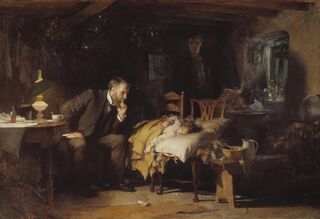Health
No Country for Old (White) Men?
A Personal Perspective: Can we seek social justice without cancelling the past?
Posted June 2, 2022 Reviewed by Gary Drevitch
Key points
- “Woke” discourse has illuminated social structures, institutions, and processes that have historically disadvantaged people of color.
- But invalidating past artwork based on today’s norms risks depriving us of powerful unifying experiences.
- In a censorious era, we must seek nuance, challenge dogmas, and lean into the complexities and universality of the human condition.
This post is co-authored by Daniel George and Kimberly Myers, Ph.D, Professor of Humanities and Medicine at Penn State College of Medicine
Two years ago, following George Floyd’s tragic death, we expanded our Health Humanities curricula at Penn State College of Medicine to more comprehensively address social injustice and exploitation. The Health Humanities are a key part of contemporary medical school education that complement scientific content by focusing on the quintessentially human facets of medicine, e.g., historical and cultural context, personal narrative, social determinants of health, bedside manner, etc.
As part of this revisioning, an initial course established a foundation of Critical Race Theory (CRT), while a second, Observation & Interpretation, was developed (by Kimberly) to use visual arts to sharpen clinical skills and promote reflection, discernment, and insight. The course includes an array of diverse images across mediums (paintings, photographs, comics) to facilitate student reflection on race, class, gender, and justice in medicine.

Enter the “old white man”
During a Zoom orientation with faculty facilitators last fall, Kimberly modeled how to guide students through the interpretation of a painting, projecting an image of The Doctor (1887), by Sir Luke Fildes (at left). In this scene, a Victorian physician contemplates a child’s serious illness while anguished parents watch from the shadows of their modest country home.
In the midst of discussion, a faculty member expressed consternation that we were dwelling on a painting of an “old white man,” i.e., the doctor in the painting. Kimberly addressed the concern, reminding discussants that art reflects the milieu in which it was produced, and that, historically, art was often commissioned by a particular person for a particular reason. Indeed, Fildes had wished to honor the care British physician Gustavus Murray had provided his 1-year-old son, who had died of typhoid. Our colleague’s well-intentioned comment left us pondering the implications for medicine and also the culture at large: Namely, can we pursue social justice and advance Diversity Equity and Inclusion goals without applying a totalizing, dismissive lens toward art of the past (or even present) that may not reflect contemporary mores?
The dark side of wokeism
To be sure, the cultural uptake of CRT, often colloquially referred to as “wokeism," has made a profound contribution, illuminating social structures, institutions, and processes that have historically disadvantaged people of color. In medicine, this discourse helps us analyze health disparities (e.g., maternal mortality) and public health phenomena (e.g., vaccine hesitancy) that have disproportionately affected communities of color. As an Arab-American (Daniel) and first-generation college student (Kimberly), our work in the curriculum and local community has sought to center voices of people of color and others (e.g., resettled refugees, working poor) who have been historically underrepresented.
Although we broadly support social justice, we find it troubling that the “particularizing” discourse of wokeism tends to reify and naturalize differences between discrete identity groups while treating “white supremacy” as a trans-historic phenomenon—a dormant evil present even in Victorian paintings. This lens can sometimes preclude appreciation of the universality of the human condition: our core unity. Indeed, paintings like The Doctor are timeless because they capture the binding force of human compassion and our shared capacity to suffer in a complex and often randomly cruel universe. When we invalidate (“cancel”) classic artworks on the basis of superficial phenotypic traits of artist/subject matter, we risk depriving students—and ourselves—of the powerful unifying experience that may come with viewing those works.
What masters does “cancellation” serve?
It is worth asking whom this sort of “cancellation” serves. As reflected in its name, “wokeism” can in its worst manifestations function as a mechanism of social control, used coercively in the “othering” of people or cultural objects regarded as “unwoke.” Ironically, wokeism can manifest as a form of secular evangelism, particularly within competitive elite institutions like universities where invocation of popular shibboleths and behavioral codes signal one’s adherence to culturally dominant orthodoxies. In this way, censorious displays of wokeness can feel performative—a means of publicly proclaiming one’s (superior) moral standing vis-à-vis the less-enlightened.
When we take a broader view on the phenomenon, this would appear to be an ancient human tendency—part of humanity’s shadow, in a Jungian sense—that is manifesting in our culture through contemporary cultural forms that have been generated by academic theory and diffused into the broader culture over the past decade in quasi-religious fashion.
Moving beyond the desire for cancellation
In our commitment to include, understand, and center multiple marginalized perspectives in this new era, we must take care not to become the very thing we decry. Specifically, we must avoid marginalizing any particular groups/subjects, especially those of us who are training future healthcare providers to devote themselves to caring for all persons, regardless of race, creed, age, or behavior.
Past artifacts and the emotions, tensions, and contradictions they surface are, in fact, decidedly positive in an educational context. A common goal of clinical training and Health Humanities pedagogy is to inculcate in students an ability to sit with uncertainty and ambiguity and think critically. Any orthodoxy that precludes open, honest inquiry and reflection among people with varying values and frames of reference jeopardizes students’ potential to form close bonds with their colleagues that come from tackling difficult questions together.
To promote the kind of open communication and mutual respect critical for high-functioning medical or other groups, we must encourage students (and remind ourselves) to seek nuance, challenge dogmas, and lean into the complexities and common denominators of the human condition. We cannot afford to get drawn into systematic eradication of past works or artists just because they fail to fit into today’s narrow ideological strictures, or because there’s social currency to be gained in doing so. To fall into this reactionary in-group/out-group trap, and thus reject the commitments to pluralism and free speech that are the bedrock of liberal societies, would be deeply regrettable and quite dangerous.




